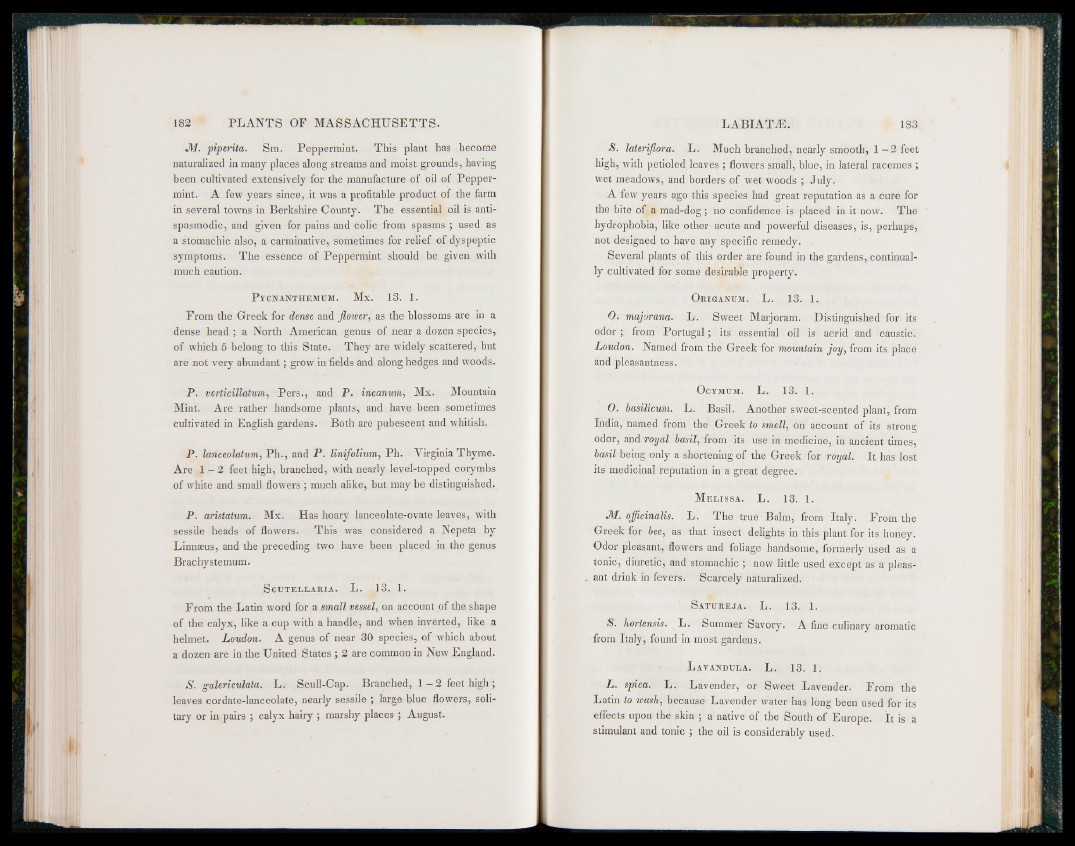
M. piperita. Sin. Peppermint. This plant has become
naturalized in many places along streams and moist grounds, having
been cultivated extensively for the manufacture of oil of Peppermint.
A few years since, it was a profitable product of the farm
in several towns in Berkshire County. The essential oil is anti-
spasmodic, and given for pains and colic from spasms ; used as
a stomachic also, a carminative, sometimes for relief of dyspeptic
symptoms. The essence of Peppermint should be given with
much caution.
P ycnanthemum. Mx. 13. 1.
From the Greek for dense and flower, as the blossoms are in a
dense head ; a North American genus of near a dozen species,
of which 5 belong to this State. They are widely scattered, but
are not very abundant; grow in fields and along hedges and woods.
P. verticillatum, Pers., and P. incanum, Mx. Mountain
Mint. Are rather handsome plants, and have been sometimes
cultivated in English gardens. Both are pubescent and whitish.
P. lanceolatum, Ph., and P. linifolium, Ph. Virginia Thyme.
Are 1—2 feet high, branched, with nearly level-topped corymbs
of white and small flowers ; much alike, but may be distinguished.
P. aristatum. Mx. Has hoary lanceolate-ovate leaves, with
sessile heads of flowers. This was. considered a Nepeta by
Linnaeus, and the preceding two have been placed in the genus
Brachystemum.
S cutellaria. L. 13. 1.
From the Latin word for a small vessel, on account of the shape
of the calyx, like a cup with a handle, and when inverted, like a
helmet. Loudon. A genus of near 30 species, of which about
a dozen are in the United States ; 2 are common in New England.
S. galericulata. L. Scull-Cap. Branched, 1 - 2 feet high ;
leaves cordate-lanceolate, nearly sessile ; large blue flowers, solitary
or in pairs ; calyx hairy ; marshy places ; August.
S. lateriflora. L. Much branched, nearly smooth, 1 - 2 feet
high, with petioled leaves ; flowers small, blue, in lateral racemes ;
wet meadows, and borders of wet woods ; July.
A few years ago this species had great reputation as a cure for
the bite of a mad-dog ; no confidence is placed in it now. The
hydrophobia, like other acute and powerful diseases, is, perhaps,
not designed to have any specific remedy.
Several plants of this order are found in the gardens, continually
cultivated for some desirable property.
Origanum. L. 13. 1.
0. majorana. L. Sweet Marjoram. Distinguished for its
odor ; from Portugal; its essential oil is acrid and caustic.
Loudon. Named from the Greek for mountain joy, from its place
and pleasantness.
Ocymum. L . 13. 1.
O. basilicum. L. Basil. Another sweet-scented plant, from
India, named from the Greek to smell, on account of its strong
odor, and royal basil, from its use in medicine, in ancient times,
basil being only a shortening of the Greek for royal. It has lost
its medicinal reputation in a great degree.
M elissa. L . 13. 1.
J\I. officinalis• L. The true Balm, from Italy. From the
Greek for bee, as that insect delights in this plant for its honey.
Odor pleasant, flowers and foliage handsome, formerly used as a
tonic, diuretic, and stomachic ; now little used except as a pleasant
drink in fevers. Scarcely naturalized.
S atureja. L . 13. 1.
/S. hortensis. L. Summer Savory. A fine culinary aromatic
from Italy, found in most gardens.
L avandula. L . 13. 1.
L . spica. L. Lavender, or Sweet Lavender. From the
Latin to wash, because Lavender water has long been used for its
effects upon the skin ; a native of the South of Europe. It is a
stimulant and tonic ; the oil is considerably used.